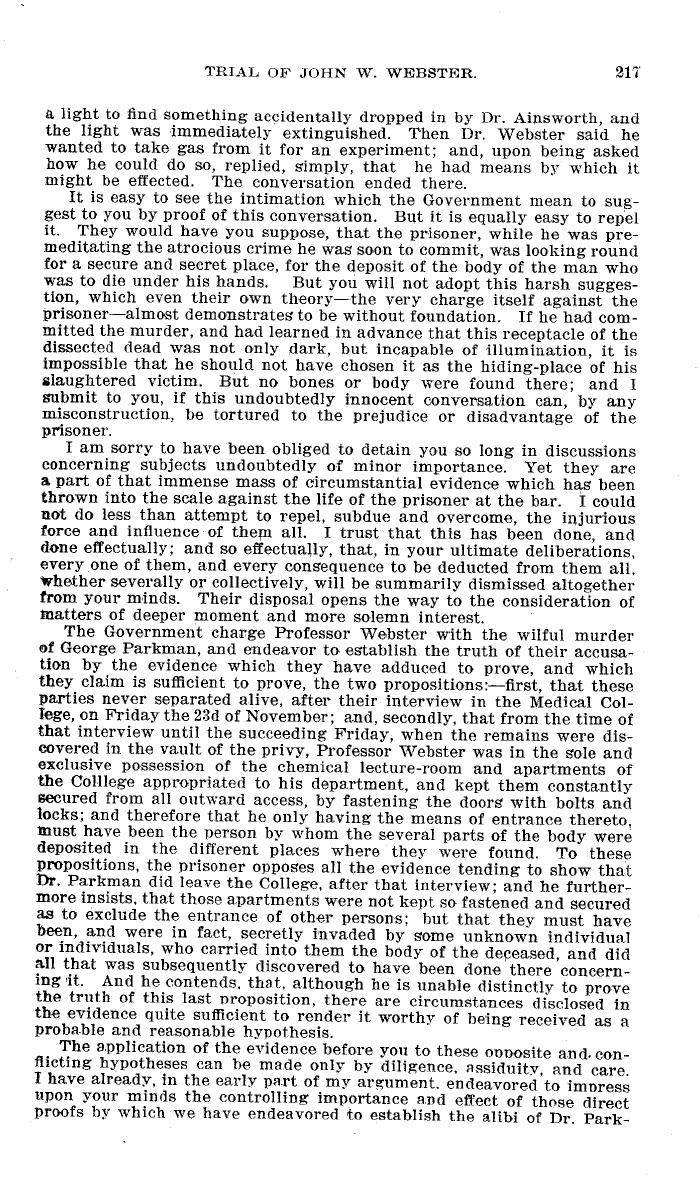|
TRIAL OF JOHN W. WEBSTER. 21,
a, light to find something accidentally dropped in by Dr. Ainsworth, and
the light was immediately extinguished. Then Dr. Webster said he
wanted to take gas from it for an experiment; and, upon. being asked
how he could do so, replied, simply, that he had means by which it
might be effected. The conversation ended there.
It is easy to see the intimation which the Government mean to sug-
gest to you by proof of this conversation. But it is equally easy to repel
it. They would have you suppose, that the prisoner, while he was pre-
meditating the atrocious crime he was soon to commit, was looking round
for a secure and secret place, for the deposit of the body of the man who
was to die under his hands. But you will not adopt this harsh sugges-
tion, which even their own theory-the very charge itself against the
prisoner-almost demonstrates to be without foundation. If he had com-
mitted the murder, and had learned in advance that this receptacle of the
dissected dead was not only dark, but incapable of illumination, it is
impossible that he should not have chosen it as the hiding-place of his
slaughtered victim. But no bones or body were found there; and I
submit to you, if this undoubtedly innocent conversation can, by any
misconstruction, be tortured to the prejudice or disadvantage of the
prisoner.
I am sorry to have been obliged to detain you so long in discussions
concerning subjects undoubtedly of minor importance. Yet they are
a part of that immense mass of circumstantial evidence which has been
thrown into the scale against the life of the prisoner at the bar. I could
not do less than attempt to repel, subdue and overcome, the injurious
force and influence of them all. I trust that this has been done, and
done effectually; and so effectually, that, in your ultimate deliberations,
every one of them, and every consequence to be deducted from them all,
Whether severally or collectively, will be summarily dismissed altogether
from your minds. Their disposal opens the way to the consideration of
matters of deeper moment and more solemn interest.
The Government charge Professor Webster with the wilful murder
of George Parkman, and endeavor to establish the truth of their accusa-
tion by the evidence which they have adduced to prove, and which
they claim is sufficient to prove, the two propositions:-first, that these
parties never separated alive, after their interview in the Medical Col-
lege, on Friday the 23d of November; and, secondly, that from the time of
that interview until the succeeding Friday, when the remains were dis-
covered in the vault of the privy, Professor Webster was in the sole and
exclusive possession of the chemical lecture-room and apartments of
the Colllege appropriated to his department, and kept them constantly
secured from all outward access, by fastening the doors with bolts and
locks; and therefore that he only having the means of entrance thereto,
must have been the person by whom the several parts of the body were
deposited in the different places where they were found. To these
propositions, the prisoner opposes all the evidence tending to show that
Dr. Parkman did leave the College, after that interview; and he further-
more insists, that those apartments were not kept so fastened and secured
as to exclude the entrance of other persons; but that they must have
been, and were in fact, secretly invaded by some unknown individual
or individuals, who carried into them the body of the deceased, and did
all that was subsequently discovered to have been done there concern-
ing it. And he contends, that, although he is unable distinctly to prove
the truth of this last nroposition, there are circumstances disclosed in
the evidence quite sufficient to render it worthy of being received as a
probable and reasonable hypothesis.
The application of the evidence before yon to these onnosite and. con-
flicting hypotheses can be made only by diligence, assiduity, and care.
I have already, in the early part of my argument. endeavored to impress
upon your minds the controlling importance and effect of those direct
proofs by which we have endeavored to establish the alibi of Dr. Park-
|

